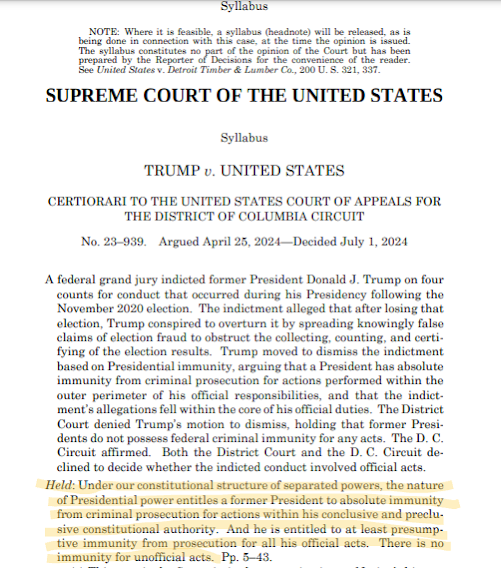In the coming days, we all will get a lesson on the meaning of the 14th Amendment, Section 1. This will be entirely because of the Trump Administration's appeal to the Supreme Court regarding the injunctions put on his Executive Order on "Brithright Citizenship".
AMENDMENT XIV
Section 1.
All persons born or naturalized in the United States, and subject to the jurisdiction thereof, are citizens of the United States and of the State wherein they reside. No State shall make or enforce any law which shall abridge the privileges or immunities of citizens of the United States; nor shall any State deprive any person of life, liberty, or property, without due process of law; nor deny to any person within its jurisdiction the equal protection of the laws.
The first sentence (in BOLD) is the sum of the clause in question in the Executive Order.
What I am interested in with this short post is the 2nd sentence, clause 1 (highlighted in YELLOW)
What the heck are "privileges and immunities"? I mean, what are they, EXACTLY? If you do a Google search, you will find articles and academic papers on the subject, but no exhaustive list of them and lots of seemingly "fuzzy" examples and/or definitions. Seems like a catch-all provision.
In several things I have read, it is suggested that an excerpt from a Supreme Court case, Corfield vs Coryell in 1823, gives the best overall explanation. It appears to be the "gold standard" explanation used in many articles/reasearch papers:
""The inquiry is, what are the privileges and immunities of citizens in the several States? We feel no hesitation in confining these expressions to those privileges and immunities which are in their nature fundamental, which belong of right to the citizens of all free Governments, and which have at all times been enjoyed by the citizens of the several States which compose this Union from the time of their becoming free, independent, and sovereign. What these fundamental principles are it would, perhaps, be more tedious than difficult to enumerate. They may, however, be all comprehended under the following general heads: protection by the Government, the enjoyment of life and liberty, with the right to acquire and possess property of every kind, and to pursue and obtain happiness and safety, subject nevertheless to such restraints as the Government may justly prescribe for the general good of the whole. The right of a citizen of one State to pass through or to reside in any other State, for purposes of trade, agriculture, professional pursuits, or otherwise; to claim the benefit of the writ of habeas corpus; to institute and maintain notions of any kind in the courts of the State; to take, hold, and dispose of property, either real or personal, and an exemption from higher taxes or impositions than are paid by the other citizens of the State, may be mentioned as some of the particular privileges and immunities of citizens which are clearly embraced by the general description of privileges deemed to be fundamental, to which may be added the elective franchise, as regulated and established by the laws or constitution of the State in which it is to be exercised. . . .
Such is the character of the privileges and immunities spoken of in the second section of the fourth article of the Constitution. To these privileges and immunities, whatever they may be – for they are not and cannot be fully defined in their entire extent and precise nature – to these should be added the personal rights guaranteed and secured by the first eight amendments of the Constitution; such as the freedom of speech and of the press; the right of the people peaceably to assemble and petition the Government for a redress of grievances, a right appertaining to each and all the people; the right to keep and to bear arms; the right to be exempted from the quartering of soldiers in a house without the consent of the owner; the right to be exempt from unreasonable searches and seizures, and from any search or seizure except by virtue of a warrant issued upon a formal oath or affidavit; the right of an accused person to be informed of the nature of the accusation against him, and his right to be tried by an impartial jury of the vicinage; and also the right to be secure against excessive bail and against cruel and unusual punishments. . .
Is this concept important? I would say so. So important that the origin of the 3 words is a part of the US Constitution; (see HERE) HOWEVER, it has a different overall meaning in its intent and execution.











.jpg)
